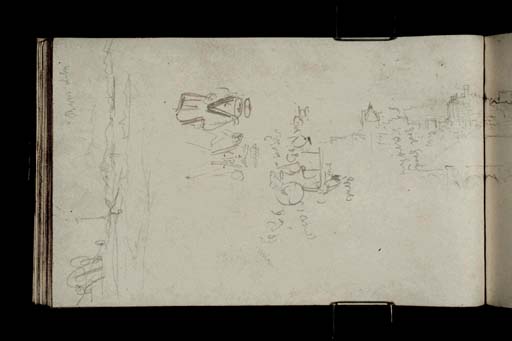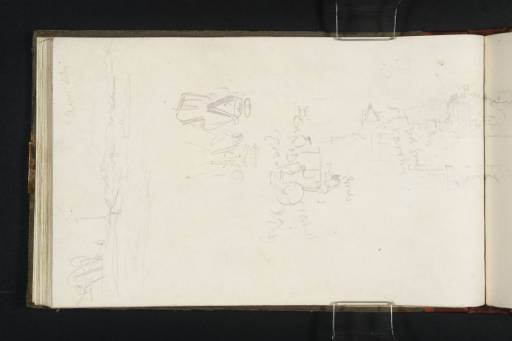Joseph Mallord William Turner Edinburgh and the Firth of Forth from Calton Hill; and Carriage and Figures Probably Associated with the Procession to Edinburgh Castle with the Regalia 1822
Image 1 of 2
-
 Joseph Mallord William Turner, Edinburgh and the Firth of Forth from Calton Hill; and Carriage and Figures Probably Associated with the Procession to Edinburgh Castle with the Regalia 1822
Joseph Mallord William Turner, Edinburgh and the Firth of Forth from Calton Hill; and Carriage and Figures Probably Associated with the Procession to Edinburgh Castle with the Regalia 1822 -
 Joseph Mallord William Turner, Edinburgh and the Firth of Forth from Calton Hill; and Carriage and Figures Probably Associated with the Procession to Edinburgh Castle with the Regalia 1822 (Enhanced image)Enhanced image
Joseph Mallord William Turner, Edinburgh and the Firth of Forth from Calton Hill; and Carriage and Figures Probably Associated with the Procession to Edinburgh Castle with the Regalia 1822 (Enhanced image)Enhanced image
Joseph Mallord William Turner,
Edinburgh and the Firth of Forth from Calton Hill; and Carriage and Figures Probably Associated with the Procession to Edinburgh Castle with the Regalia
1822
Joseph Mallord William Turner 1775–1851
Folio 35 Verso:
Edinburgh and the Firth of Forth from Calton Hill; and Carriage and Figures Probably Associated with the Procession to Edinburgh Castle with the Regalia 1822
D17563
Turner Bequest CC 35a
Turner Bequest CC 35a
Pencil on white wove paper, 114 x 187 mm
Inscribed in pencil by Turner ?‘Burntisland’ top left running vertically, ?‘grand’ | ‘crowd’ [or ‘archers’] centre descending vertically, ‘[...] [...] | ?‘archers’ [or ‘arthur’] centre right descending vertically
Blindstamped with the Turner Bequest stamp top right
Inscribed in pencil by Turner ?‘Burntisland’ top left running vertically, ?‘grand’ | ‘crowd’ [or ‘archers’] centre descending vertically, ‘[...] [...] | ?‘archers’ [or ‘arthur’] centre right descending vertically
Blindstamped with the Turner Bequest stamp top right
Accepted by the nation as part of the Turner Bequest 1856
References
1909
A.J. Finberg, A Complete Inventory of the Drawings of the Turner Bequest, London 1909, vol.I, p.611, CC 35a, as ‘Edinburgh from Calton Hill, and other sketches.’.
1975
Gerald Finley, ‘J.M.W. Turner’s Proposal for a “Royal Progress”’, The Burlington Magazine, vol.117, January 1975, p.35 note 32 as ‘Views of Edinburgh from Calton Hill (related to pencil composition no. 16 of the “Royal Progress” series); the King’s carriage; Beefeaters; compositions perhaps related to the Regalia ceremony held at Holyrood; view of Craigmillar Castle’.
1981
Gerald Finley, Turner and George the Fourth in Edinburgh 1822, exhibition catalogue, Tate Gallery, London 1981, pp.83, [132] reproduced.
The page contains sketches of views from the top of Calton Hill which Gerald Finley associates with composition ‘16’ of a series of compositions making up a plan for a Royal Progress (see the King at Edinburgh 1822 sketchbook; Tate D40979; Turner Bequest CCI 43a). This composition illustrates the procession to Calton Hill associated with the ceremony of the laying of the foundation stone of the National Monument. The two sketches in question show views from two sides of Calton Hill.
At the right of the page is a view looking west towards Edinburgh (continued on folio 36; D17564) familiar from sketches in 1818 (Tate D13651–D13652, D13654; Turner Bequest CLXVII 39a–40, 41) and the subsequent watercolour Edinburgh from Calton Hill, circa 1819 (National Gallery of Scotland).1 At the left of the view is the open crown spire of St Giles’s Cathedral with Edinburgh Castle to its right and North Bridge beneath. Turner also used the view for his watercolour March of the Highlanders, circa 1836 (Tate N04953) which was engraved by T. Higham in 1836 for Fisher’s Illustrations to the Waverley Novels of Sir Walter Scott. The picture is of an event which preceded the laying of the foundation stone of the National Monument on 27 August 1822.2
At the left of the page, drawn with the sketchbook turned to the right, is a view from Calton Hill looking north across the Firth of Forth towards Burntisland in Fife. Calton Hill is in the left foreground and the island of Inchkeith can be seen at the right.
The backs of two costumed figures, one with ‘GR’ (George Rex, the King’s royal cipher) emblazoned on his tunic, could be figures sketched during the foundation stone ceremony as they somewhat resemble costume sketches at that event (see folio 26 verso; D17548). However, the character of the sketch differs considerably from the others executed on that occasion which were made from the top of Nelson’s Monument (see folio 22 verso; D17540), and there is no reason to assume that just because these sketches relate to composition ‘16’ and the foundation stone ceremony that they were made on the same day.
Finley regards the figures as relating to the ‘Regalia ceremony held at Holyrood’ on 14 August 1822 (see folio 36).3 However, a more likely explanation for the figures and carriage is the procession to Edinburgh Castle with the Regalia on 27 August. Their costumes certainly fit John Prebble’s description of the event’s ‘medieval flummery’ which included ‘trumpeters and heralds, pursuivants in red and yellow tabards, yeomen and henchmen, macers, esquires, equerries and grooms’.4 There is also a similar study of two costumed figures on folio 36 verso (D17565) which contains a drawing of the event with the arrival of the King’s coach from the battlements of the castle.
The procession, devised by Sir Walter Scott and inspired by the ancient Riding of Parliament, took the King, his entourage and the bearers of the Regalia from Holyrood along the Royal Mile to the castle. The route was lined with stands for representatives of the city’s public life, authorities and trades, as well as being packed with standing spectators and colourful decorations. Because of the persistent rain, the King came out in a closed carriage, rather than an open landau as had been expected and hoped for. This is the vehicle shown in Turner’s drawing, surrounded by ceremonial guards and of course the bearers of the Regalia.
Turner regarded the rest of the event from the battlements of the castle (see folio 36 verso), although when he came to illustrate the ceremony for volume 1 of the 1826 bound edition of The Provincial Antiquities and Picturesque Scenery of Scotland, he showed the view from the Royal Mile looking up towards the castle, a design perhaps based more on a watercolour by James Skene: King George IV at Edinburgh Castle, circa 1822 (Edinburgh City Libraries) than any sketch made by Turner.
Thomas Ardill
September 2008
How to cite
Thomas Ardill, ‘Edinburgh and the Firth of Forth from Calton Hill; and Carriage and Figures Probably Associated with the Procession to Edinburgh Castle with the Regalia 1822 by Joseph Mallord William Turner’, catalogue entry, September 2008, in David Blayney Brown (ed.), J.M.W. Turner: Sketchbooks, Drawings and Watercolours, Tate Research Publication, December 2012, https://www

